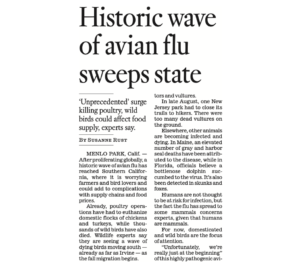Beef prices are projected to continue increasing as U.S. beef production declines with no signs of a cattle herd rebuild. Additionally, cheap beef may soon become further out of reach…
Low Waters on Mississippi River Creates “Logjam,” as Bird Flu Spreads in California
Bloomberg writers Michael Hirtzer, Elizabeth Elkin, and Joe Deaux reported yesterday that, “A logjam of more than 100 ships, tugboats and their convoys of barges in the shrinking Mississippi River is threatening to grind trade of grains, fertilizer, metals and petroleum to a halt.
“The largest US barge operator warned customers it won’t be able to make good on deliveries. Ingram Barge Company declared force majeure in a letter to customers due to ‘near-historic’ low water conditions on the Mississippi, the top route to get US grains and soybeans to the world market.
42% of the Oct-Dec 2021 U.S. exports of #soybeans to #China left from the Gulf, a flow that is now jeopardized due to low river levels. Chinese soymeal prices recently hit record highs due to lower soy imports this year. U.S. transport issues will not be helpful. pic.twitter.com/Rz8cmKQMLM
— Karen Braun (@kannbwx) October 5, 2022
“Drought has dwindled water levels along the biggest US waterway by so much that vessels are running aground. The Coast Guard is responding to grounded vessels in at least two places, near Stack Island in Louisiana and upriver near Memphis, according to a statement.”
Here's a look at how Sept 2022 rainfall measured up at several long-running stations. Driest in 150 years for Minneapolis, with many top 10s across the region. #MidwestClimate #drought pic.twitter.com/2BW7vVoj0C
— MRCC (@MidwestClimate) October 5, 2022
The Bloomberg writers explained that, “The logjam is coming at the worst time as the soybean and corn harvests are each about one-fifth complete and supplies will start piling up. The river woes, coupled with a soaring dollar, are destroying demand for US supplies even with Russia’s invasion of Ukraine still impeding shipments in the Black Sea.”
7. Last map did not indicate NOLA extremely low MS water level yet. Consistent with this chart. Seasonal lows in water levels this time of year. pic.twitter.com/t8u12vK4AL
— Scott Irwin (@ScottIrwinUI) October 4, 2022
Also yesterday, Dow Jones writer Kirk Maltais reported that, “Dry weather is keeping water levels at historic lows in the Mississippi River according to media reports – causing a back-up in river barges. Meanwhile, DTN is forecasting little rainfall in the Midwest until next week. For traders uncertain about export demand prospects for U.S. grains, issues with the river are a source of price pressure. ‘Gulf exporters have pulled offers for corn and soybeans loading in October and November as it is unclear if they can source enough grain,’ Joel Karlin of Western Milling told the WSJ.”
And Reuters writer Naveen Thukral reported today that, “The U.S. harvest of corn and soybeans is progressing under clear skies across much of the Midwest this week, adding seasonal pressure to the markets as traders monitored yield reports from farmers.”
Earlier this week, Reuters writer Karl Plume reported that, “Commercial barge traffic on southern stretches of the Mississippi River was at a standstill on Tuesday as low water levels halted shipments of grain, fertilizer and other commodities on the critical waterway, shipping sources said.
“The supply chain snarl comes just as harvesting of corn and soybeans, the largest U.S. cash crops, is ramping up and as tight global supplies and strong demand for food and fuel have sent inflation soaring.”
Plume added that, “Around 100 tow boats hauling some 1,600 barges were lined up for miles waiting to pass through one trouble spot near Lake Providence, Louisiana, that has been largely closed since late last week, shipping sources said.
“At least two other sections of the lower Mississippi have also been closed at times, disrupting the flow of grain to U.S. Gulf Coast export terminals, where some 60% of U.S. corn, soybean and wheat exports exit the country, they said.”
Elsewhere, Susanne Rust, writing on the front page of the Business section in today’s Los Angeles Times, reported that, “After proliferating globally, a historic wave of avian flu has entered Southern California, where it is worrying farmers and bird lovers and could add to complications with supply chains and food prices.

“Already, poultry operations have had to euthanize domestic flocks of chickens and turkeys, while thousands of wild birds have also died. Wildlife experts say they are seeing a wave of dying birds moving south — already as far as Irvine — as the fall migration begins.
“Authorities describe the surge as ‘unprecedented‘ in scope, breadth and lethality.”
Today’s LA Times article noted that, “‘Unfortunately, we’re really just at the beginning‘ of this highly pathogenic avian influenza outbreak, said Dr. Maurice Pitesky, an expert in poultry health and food safety epidemiology at UC Davis. He noted that millions of birds are just beginning their southward migration from summer feeding grounds in the Arctic — a place where they’ve been mingling and communing with species from across the globe.
“‘Some disease models show that we are going to get hammered this fall,’ Pitesky said, noting it could add stresses to the food supply, which is already being clobbered by high corn and soy prices — the food required to keep the millions of chickens and turkeys in poultry farms alive.”





